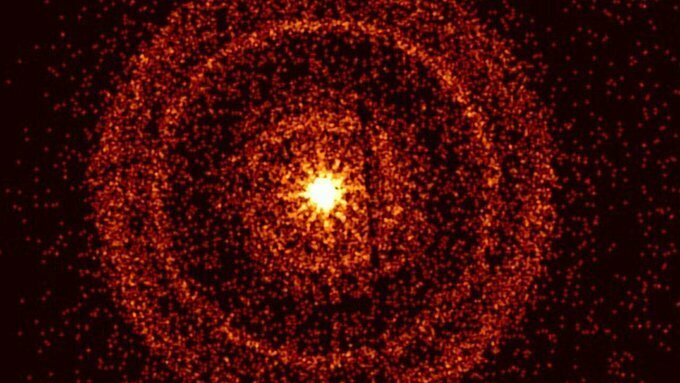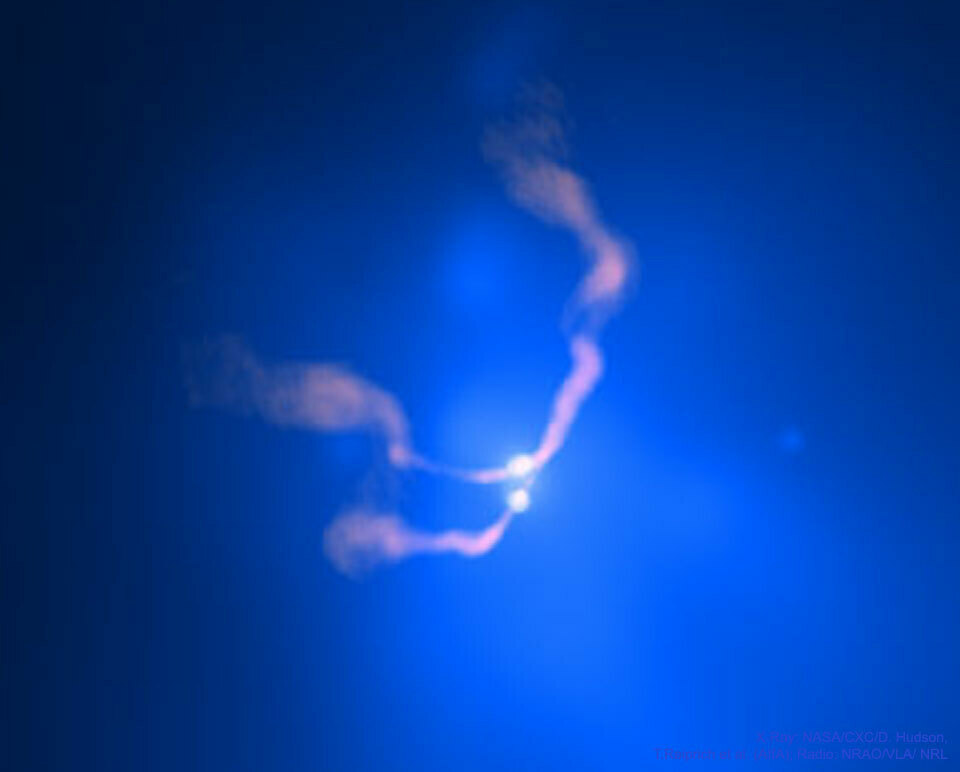4 Likes
1 Comments
typically technically...

#typically #technically #blackholes #awesome #dope #fucking #hell #wikipedia #description
https://mastodon.social/@vicgrinberg/110299510153842692 vicgrinberg@mastodon.social - So what kinds of black holes are actually out there?

The burst of gamma-rays -- the most intense form of electromagnetic radiation -- was first detected by orbiting telescopes on October 9, and its afterglow is still being watched by scientists across the world.
Astrophysicist Brendan O'Connor told AFP that gamma-ray bursts that last hundreds of seconds, as occurred on Sunday, are thought to be caused by dying massive stars, greater than 30 times bigger than our Sun.
The star explodes in a supernova, collapses into a black hole, then matter forms in a disk around the black hole, falls inside, and is spewed out in a jet of energy that travels at 99.99 percent the speed of light.

Image of the black hole at the center of the Milky Way galaxy. Recall that the first black hole image was of a supermassive black hole at the center of Messier 87 (M87) in April of 2019. The reason that one was done first is that, even though M87 is so much further away (53.5 million light-years), the supermassive black hole there is so supermassive -- 1,500 times more massive -- that it's angular size in the sky is actually about the same as the black hole at the center of the Milky Way, and that combined with the fact that it's not obscured by the same dust that sits between us and the center of the Milky Way means it's actually easier to see. Gas in the vicinity of Sagittarius A* complicates matters even further. "The gas in the vicinity of the black holes moves at the same speed -- nearly as fast as light -- around both Sagittarius A* and M87*. But where gas takes days to weeks to orbit the larger M87*, in the much smaller Sagittarius A* it completes an orbit in mere minutes. This means the brightness and pattern of the gas around Sagittarius A* were changing rapidly as the Event Horizon Telescope Collaboration was observing it -- a bit like trying to take a clear picture of a puppy quickly chasing its tail."
By the way, the black hole in M87 is called M87*, and the black hole at the center of the Milky Way is called Sagittarius A*, because it's in the constellation Sagittarius, and the asterisk indicates it's at the center of a galaxy.
Both images are made by the Event Horizon Telescope, which is actually not one telescope but a 'virtual telescope' made by combining 8 radio telescope clusters around Earth, so that the create one Earth-sized telescope. They are not physically connected and their data is synchronized with atomic clocks. The telescopes are located in Chile, Spain, Hawaii, Mexico, Arizona, Greenland, and the south pole.
So what did we learn about Sagittarius A*? "The orbital period at the innermost stable circular orbital is 30 minutes or less, significantly shorter than the 12-hour observation we would ideally use to obtain an Earth-rotation synthesis image. Additionally, the image of Sagittarius A* is partially blurred by turbulent plasma along the line of sight to the Galactic Center, an effect which prevents resolution of the ring at longer wavelengths. The collaboration employed a number of traditional and novel techniques to assess and correct for these effects. Across all techniques, we demonstrate very strong evidence for a ring with a diameter of 52 microarcseconds."
Regarding the accretion disk, they say, "In spite of the extraordinary depth and range of the theoretical simulations produced in our analyses, none of the models meet all of the observational constraints. Variability stands out as providing particularly challenging criteria to meet in future modeling efforts. Magnetically arrested disks at low inclination angle are among the best performing models."
The black hole is confirmed to be a Kerr black hole with mass of about 4 million times the mass of the sun. A Kerr black hole is a type of black hole that has mass and angular momentum but not electrical charge, and as such, can be described by a particular set of solutions to Einstein's general relativity that apply to that specific case. Those equations were figured out by a New Zealand mathematician named Roy Kerr in 1963. Kerr black holes are formed from very massive stars and retain the angular momentum of the stars they formed from. Comparison with computer simulations indicates that the Sagittarius A* black hole is spinning but is not being viewed from a high inclination (in other words, we are viewing it from the top and not from the side -- the "inclination" of the viewing angle from the pole is estimated to be less than 30 degrees) and the accretion disk rotates the same way (that is, it does not have a retrograde accretion disk).
The reason the astronomers were unable to fit the observations to any other computer models is because of a high amount of "variability" in the observations. They tried to explain this variability by the effects of interstellar scattering, however found that was insufficient. They don't believe it comes from the telescopes themselves. This implies it is coming from Sagittarius A* itself, but they don't have any computer models that would explain it.
Astronomers reveal first image of the black hole at the heart of our galaxy
#astronomy #BlackHoles #GravitationalLens #AGN An article published in "The Astrophysical Journal" reports a study on a double X-ray source in the early universe cataloged as MG B2016+112 which could be composed of two supermassive black holes whose image is distorted by a gravitational lens.
https://english.tachyonbeam.com/2021/09/05/possible-pair-of-primordial-supermassive-black-holes-identified/
Gravitational waves from star-eating black holes detected on Earth
Spacetime-altering shock waves came from massive neutron stars crashing into black holes millions of years ago
I’m an just an #undergraduate #student of #physics, trying to set myself up to flirt with #astrophysics, with a weakness for and in #blackholes, though occassionaly ogling at her sister, #cosmology, but again pulled back to stare at #quasars through only my minds eye. Did I mention that I am #newhere? If not then, I should also mention that #instrumentation and #electronics too share alarge bit of my metaphorical heart, and I just love #interfacing; what's better, than to connect physical reality to a beast a.k.a a #computer? Well #micro-controllers? I just started using an #arduino, actually an #arduinouno ( #arduinounor3 ), currently learning programing and using it for small, if not infinitesimally small, if you can call them that is, #electronicsprojects; I will soon push myself to use an #expeyes. Yeah, #microcontrollers interest me, but, as much as do #microprocessors, #8085 being one, with which I've played a little, though only through simulations. I needn't shy away from stating that I love #programing, having some knowledge in #C, #C++, #java, a little bit of #fortran. I'm learning to #code or #script, whichever way you like, #python, rather it's newborn sibling, #python3. It's no need to say that my #operatingsystem of choice, use and love is a of course, a popular distribution of #linux, i.e. #xubuntu; #xfce is my and my PC's best bond of love, along with #bash and #zsh. I love watching #movies, especially heart-moving #warfilms, thought provoking #darkcomedies, saluted #satires, divinely appetizing #epics, #neoreals, that leave you speechless, and some more and more to come; I so love #shortfilms that I do wish to someday, #make one. Well, you may call me an amateur, but I am a #photographer, #photography, being one of my passtime passions, #astrophotography, being one of my dreams, not having been able to capture a proper one yet. I have only taken part in a few well-known #photowalks, spread through social-media.
You know, like me or not, I strongly believe in #foss, especially #fosss, being a #privacy and #security concerned person, if not a #customization freak, an embryo of a #hacker and of course a #linuxlover. If that seems a bit commonplace, well it is, then I also happen to be a fan of a #marsrover; ah! #mars or Jasoom, call it what may, it's lovely. But lovelier are the #rovers that graze on it's surface. I so wish that I had a pet #quadcopter alongside my late pet #cat. Cool is the only word I can have for #robots; ah! #robotics, what a sweet art art thou. Though a little sweeter would be #cognition, whose daughter #ai is a sweet child, I wish was mine. Can #intelligence be #artificial? Or is it just another #random #oxymoron, that a #language is filled with, that #linguistics deals with? Or maybe I'm just writing a #microtale. But then, #microtales are so lovely. Be it in #english or #bengali, rather #bangla, or #hindi or #german; though for #deutsch I still need a dictionary. At least #scrabble and #hangman are still in english for me. But yes, I just happened to fall in love with #html5 and #markdown.
EIne der bedeutendsten #Entdeckungen in der #Wissenschaft, sind die #Gravitationswellen. Die Forscher arbeiten seit über 100 Jahren daran. Nun ist es gelungen. Aber was sind Gravitationswellen? In diesem kurzen Filmchen werden sie erklärt.
https://www.youtube.com/watch?v=mtCAmb_Mg1k&feature=youtu.be
#astronomie #astronomy #blackholes #schwarzelöcher #Forschung #science